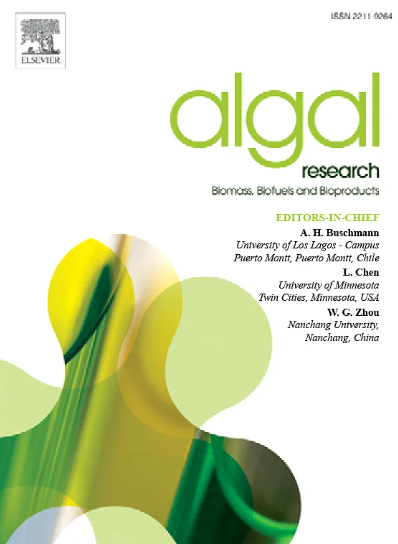From seaweeds to skincare: Unveiling the dermatological potential of Bifurcata bifurcata
IF 4.6
2区 生物学
Q1 BIOTECHNOLOGY & APPLIED MICROBIOLOGY
Algal Research-Biomass Biofuels and Bioproducts
Pub Date : 2025-04-26
DOI:10.1016/j.algal.2025.104068
引用次数: 0
Abstract
Society has become more aware of the significance of a healthy skin, resulting in a growing need for natural and innovative skin care products. Seaweeds are known to be a rich source of bioactive compounds with a wide range of biotechnological applications. Therefore, the aim of this study was to evaluate the dermatological potential of six fractions (F1-F6) obtained from the brown seaweed Bifurcaria bifurcata. The antioxidant, anti-enzymatic, cytotoxic, photoprotective, wound healing, and antimicrobial properties were studied. The ethyl acetate fraction (F4) displayed the best ability to scavenge the 2,2-diphenyl-1-picrylhydrazyl (DPPH) radical (EC50: 35.7 μg/mL), also demonstrating the highest anti-enzymatic activity, inhibiting collagenase and tyrosinase activities with an IC50 value of 33.6 μg/mL and 50.1 μg/mL, respectively. The hydrophilic fraction (F5) exhibited the highest photoprotective capacity, reducing the reactive oxygen species (ROS) production by 30.9 % on HaCaT cells exposed to UVA/B radiation compared with the vehicle. By contrast, the solid water-insoluble fraction (F2) promoted the highest wound healing area (47.3 %). Finally, the cyclohexane fraction (F3) showed the highest antimicrobial activity, inhibiting Staphylococcus epidermidis (48.5 % at 200 μg/mL) and Cutibacterium acnes (IC50: 59.0 μg/mL) growth. Based on these results, B. bifurcata reveals to be a promising source of bioactive ingredients for the development of innovative multitarget dermatological products.
从海藻到皮肤护理:揭示双裂的皮肤病学潜力
社会越来越意识到健康皮肤的重要性,因此对天然和创新的护肤品的需求越来越大。众所周知,海藻是生物活性化合物的丰富来源,具有广泛的生物技术应用。因此,本研究的目的是评价从褐藻Bifurcaria bifurcata中获得的6个馏分(F1-F6)的皮肤学潜力。研究了其抗氧化、抗酶、细胞毒、光保护、伤口愈合和抗菌性能。乙酸乙酯部分(F4)对DPPH自由基的清除能力最强(EC50值为35.7 μg/mL),对胶原酶和酪氨酸酶的抑制作用最强(IC50值分别为33.6 μg/mL和50.1 μg/mL)。亲水部分(F5)表现出最高的光保护能力,与载体相比,暴露于UVA/B辐射下的HaCaT细胞的活性氧(ROS)产量减少30.9%。而固体水不溶性部分(F2)对创面愈合面积的促进作用最大(47.3%)。最后,环己烷部分(F3)的抑菌活性最高,抑制表皮葡萄球菌(200 μg/mL)和痤疮表皮杆菌(IC50: 59.0 μg/mL)的生长。基于这些结果,双歧杆菌揭示了一个有前途的生物活性成分的来源,为开发创新的多靶点皮肤产品。
本文章由计算机程序翻译,如有差异,请以英文原文为准。
求助全文
约1分钟内获得全文
求助全文
来源期刊

Algal Research-Biomass Biofuels and Bioproducts
BIOTECHNOLOGY & APPLIED MICROBIOLOGY-
CiteScore
9.40
自引率
7.80%
发文量
332
期刊介绍:
Algal Research is an international phycology journal covering all areas of emerging technologies in algae biology, biomass production, cultivation, harvesting, extraction, bioproducts, biorefinery, engineering, and econometrics. Algae is defined to include cyanobacteria, microalgae, and protists and symbionts of interest in biotechnology. The journal publishes original research and reviews for the following scope: algal biology, including but not exclusive to: phylogeny, biodiversity, molecular traits, metabolic regulation, and genetic engineering, algal cultivation, e.g. phototrophic systems, heterotrophic systems, and mixotrophic systems, algal harvesting and extraction systems, biotechnology to convert algal biomass and components into biofuels and bioproducts, e.g., nutraceuticals, pharmaceuticals, animal feed, plastics, etc. algal products and their economic assessment
 求助内容:
求助内容: 应助结果提醒方式:
应助结果提醒方式:


